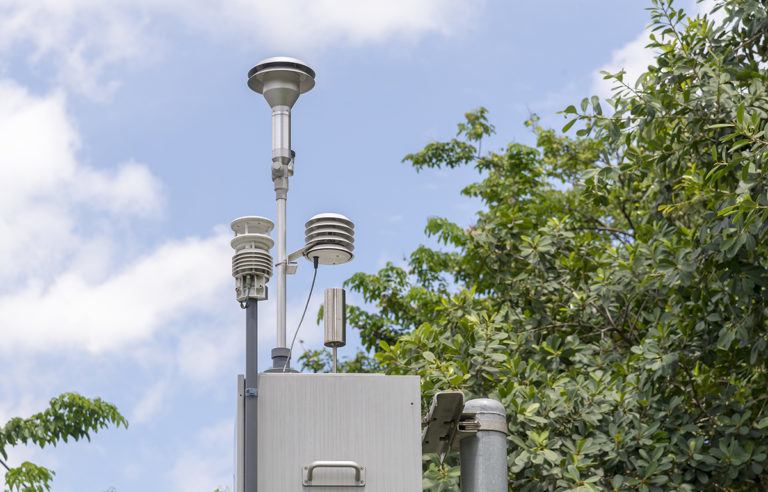Forecasting for better air quality: The impact of air monitors on tribal lands in Minnesota

When we think of Minnesota, we think a lot about the water. We’re known for our lakes and the headwaters of the Mississippi so people may overlook the fact that our air quality is also overall pretty great. Great air is the result of many factors contributing to our skies remaining clear and Minnesotans breathing easy.
Air quality forecasting and air quality monitoring are the first steps in the process of ensuring Minnesotans breath clean air. Forecasting is done by taking data from monitors and analyzing it for information on emissions of air pollutants and how they affect the overall quality of our air. In Minnesota, there are 50 monitors across the state and on sovereign Tribal lands that provide data to create the air quality picture for the state.
Only recently has a partnership to install and include monitoring data gathered by Tribal governments been included. The data collected by the Tribes is an integral piece of the puzzle in order to keep Minnesotans healthy during low air quality days.
How We Got Here
In 2003, the Leech Lake Band of Ojibwe installed its first particulate matter monitor. The monitor was an older style that required changing out a filter once a week to get data from the previous week. Filter based data was collected until 2017 and though it provided a better air quality picture for the region, the data was not usable by the Minnesota Pollution Control Agency (commonly referred to as the MPCA.) In the mid 2010s there was a real push to build a partnership between Tribal governments and the State of Minnesota to install monitors that could be included in the state network.
In late 2018, Leech Lake installed a BAM (beta attenuation monitor) to provide real time data collection compatible with the data collected from other sites across Minnesota. The first time that the BAM was turned on, the measurements of particulate matter were so high that the Minnesota Pollution Control Agency thought the readings were incorrect. They readings were indeed accurate and offered proof that data from the Leech Lake Nation monitor was providing crucial information on the overall air quality picture in Minnesota.
True Partnership
Building partnerships between state agencies and Tribal governments requires great care and respect. As Tribal lands are sovereign territory it’s not as easy as a partnership between agencies and the partnership around air monitoring in Minnesota is a great study in relationship building. Staff from MPCA attended meetings of the Minnesota Tribal Environmental Committee to, first and foremost, listen. Agency staff also expressed how vital they believed the partnership to be as the data added to the statewide repository would be for the betterment of everyone in the state.
The respect for sovereignty is also present in the technical relationship between the Tribes and the State. All of the monitors on Tribal lands are run and maintained by the respective Tribes. However, MPCA calibrates and conducts site visits to ensure that the monitors are running correctly. When the monitor with Leech Lake needed a replacement part and it could not be sourced quickly, the MPCA provided a temporary replacement until the manufacturer could send the new part.
Outcomes
Many positive outcomes have resulted from the inclusion of monitors on Tribal lands.
- Better forecasting to identify when air quality will be dangerous for at-risk Minnesotans.
- Pollution tracking over time.
- Demonstration of whether the state is meeting air quality standards.
This partnership has also contributed to Minnesota being a leader in air quality forecasting by recognizing Tribal Nations in air quality alerts. The MPCA sends air quality data to the National Weather Service which issues the alerts. This important change results in notification for Tribal Nations in addition to counties within Minnesota. As the Leech Lake Reservation alone spreads across four counties in Northern Minnesota, the change is a much more accurate way to alert Tribal members than by county alone. Minnesota the only state in the country to release alerts that recognize Tribal Nation boundaries. Leech Lake Band transforms the data into information campaigns which include email, social media, Enviroflash and website updates to reach Tribal members who are at risk.
The powerful partnership built around air quality monitoring is important for the Tribes and the state agencies. Everyone in Minnesota benefits.
Brandy Toft has worked for the Leech Lake Band of Ojibwe since 2001 and has been the Environmental Deputy Director since 2016. She has worked on a multitude of air quality projects and serves on numerous local, regional and national workgroups and boards. Her contributions and leadership have been recognized multiple times, most recently through her reception of the Taimi Lynn Hoag Award in 2021.